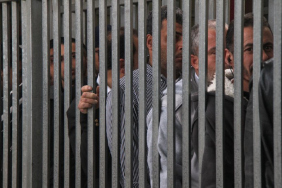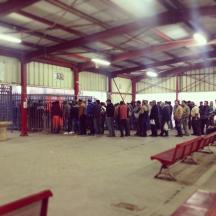Translator: Charles K.

After the conquest of the West Bank in 1967 Israel annexed East Jerusalem. It was, and had been for centuries, the center of activity for inhabitants of the West Bank because of its hospitals, schools and places of employment, and because of its religious significance.
Palestinians in East Jerusalem received Israeli identity cards and became Israeli residents while their compatriots on the West Bank are not allowed free entry to the city. As soon as the Qalandiya checkpoint was erected and the separation wall constructed Palestinians living beyond the wall were cut off from residents of East Jerusalem. Palestinians wishing to reach a hospital in Jerusalem, children going to school, people heading to work – all must constantly renew permits to go through the checkpoint. Tens of thousands of Palestinian residents of Jerusalem who were left beyond the wall must also go through the checkpoint and show their Israeli ID card. Thousands of laborers from throughout the West Bank with crossing permits and work permits go through this checkpoint every morning.
But the checkpoint, located within Jerusalem’s municipal boundary, is unable to handle the number of people wishing to enter Jerusalem during rush hour. The inhuman congestion and humiliating, shocking conditions in which people are forced to wait make Palestinians suffer greatly and expose the inability of the occupation authorities to solve the problems they themselves have created. The checkpoint has a terrible reputation because of the humiliating and degrading treatment of the Palestinians it is supposed to serve.
Since the Qalandiya checkpoint was erected in 2001, women from Machsom Watch have come there a few times a week, closely observing its operation and calling attention to the difficult conditions and suffering imposed on all who must use it. Here is a video on the checkpoint, produced and photographed by me.
The management structure of the Qalandiya checkpoint, through which 8,000-10,000 people cross daily, is in the shape of a pyramid composed of  different authorities with separate areas of jurisdiction. That means it’s “all and nothing.” The result of this separation of authority is that each individual entity can avoid taking overall responsibility, which increases the burden on the Palestinians who have to go through every day.
different authorities with separate areas of jurisdiction. That means it’s “all and nothing.” The result of this separation of authority is that each individual entity can avoid taking overall responsibility, which increases the burden on the Palestinians who have to go through every day.
When the checkpoint was transformed into a “crossing” (newspeak for a facility whose main purpose is to prevent people from crossing) it came under the authority of the police, like border crossings at airports and between countries. The police, therefore, are at the top of the pyramid, and are represented at the checkpoint by a police officer. He told us he’s responsible for order and security. He’s in charge of the female soldiers who push the button to operate the revolving gates at the entrance to the “sleeves” (fenced corridors similar to those through which cattle move to holding pens).
at the entrance to the “sleeves” (fenced corridors similar to those through which cattle move to holding pens).
Below him, though not subordinate in authority, is the DCL representative (the Civil Administration , newspeak for “military rule”). He’s responsible for opening the “humanitarian gate” serving people with disabilities, women and children. The police officer is not allowed to open the humanitarian gate; the DCL representative is not allowed to open the revolving gates.
, newspeak for “military rule”). He’s responsible for opening the “humanitarian gate” serving people with disabilities, women and children. The police officer is not allowed to open the humanitarian gate; the DCL representative is not allowed to open the revolving gates.
The military police are a third important component of the pyramid. The male or female MP is responsible for inspecting people going through the “sleeves.” Neither the civilian police officer nor the DCL representative has authority over the sleeves or the inspections conducted there. If not all sleeves have been manned in the morning by MPs, and if the male MP flirts with the female MP, who’s flirting with her cellphone, thereby stopping the flow of people hurrying to work – neither the civilian police nor the DCL representative can do anything about it. If inspections within the “sleeves” are taking a very long time because an inexperienced new squad has replaced the previous unit (as they explained to us), neither the civilian police officer nor the DCL representative is allowed to intervene. If the DCL representative answers nature’s call and goes to the bathroom, and while he’s gone a long line of women, children, the disabled and the elderly forms at the humanitarian gate, the civilian police officer is not allowed to open it.
The guard employed by the private security company is at the bottom of the pyramid. His job is to protect everyone else. And when they all gather gossiping in the sealed glass-walled room they can neither hear what’s happening outside nor have they a clear view of all the fenced corridors.
After having stood at the Qalandiya checkpoint in the morning for years I took a break. I could no longer bear the terrible, unchanging situation. I have a choice – I can stay in bed. The Palestinians can’t. They must go to work. They have to earn a living. They reach their jobs through the Qalandiya checkpoint. It’s an inseparable part of their lives.
But here I am at the checkpoint once again, and again feel the same helplessness, frustration and anger. The stupidity, folly and cumbersomeness of the checkpoint’s operation, the obtuseness and indifference to the Palestinians’ suffering - are beyond my comprehension.
At the moment fenced corridor no. 5 is almost empty. Open corridor 5, open it, it’s empty! I yell, I grow hoarse – and no one hears me.
